A planet where apes evolved from men? Well, it is not quite as outré as the 1968 film that famously pitted Charlton Heston against a bunch of science-minded orang-utans and gun-totin’ gorillas. (Perhaps this is why Heston is such an advocate of the right to bear arms?) Instead, we are given a choice: Africa or Europe? That is the question that anthropologist David Begun would like us to ponder when considering where apes evolved and how this process shaped the many evolutionary trajectories seen in the fossil record and the extant primates, including, of course, us.
Rather than offering yet another narrative account of human evolution, Begun adopts a refreshingly broad approach by exploring the evolution of the apes as a whole. While it is hard not to argue that we humans are an unusual animal, to assert that we are unique is to dismiss our shared heritage. All of the apes are unusual animals. Large brains (relative to body size), complex social groups, sophisticated communication and problem-solving: these might sound like a list of “human” attributes, but in fact are common to the whole ape superfamily. It is degrees of difference, not types of difference, that separate us from our ape cousins.
Admittedly, the geographical question that Begun uses to frame his book’s oppositional narrative is something of a red herring. The modern names of continents or countries do not have any real relevance (apart from political-style bragging rights) to the evolutionary process. What is more important is the micro-scale ecology (the day-to-day conditions, we might say) on the ground, and the large-scale environmental trends over thousands and millions of years that provide a backdrop for natural selection, which, when combined with fossils, genetics and other data, allow us to try to reconstruct what happened, when and why.
There is much to like in this enjoyable book. A highlight is its introduction, which makes the rather dull Linnaean rules that determine what a primate is (and isn’t) jump off the page and grab the reader’s attention. If you are confused by the intricacies surrounding primate and human evolution, this section is the solution to unlocking the more complex arguments that drive our understanding. Begun writes in a friendly, almost conversational style throughout, and frequently breaks the fourth wall, as it were, to share anecdotes with the reader. (This sort of chattiness is an increasingly common approach in books by academics in the past few years, and I’m a bit undecided about how much I like it.) Begun generously gives time to the theories of researchers with whom he disagrees, and almost everyone is called “my colleague”, which suggests that we play together much more nicely than we really do. I must admit to being slightly unconvinced by the book’s subtitle, A New Story of Human Origins – it reads suspiciously like a marketing add-on, rather than anything to do with Begun’s eloquent, persuasive and carefully worked arguments.
Perhaps the best advice that I can offer is a paraphrase of the immortal words uttered by Heston’s character in the eponymous film: “Get your stinking paws on this book, you damn dirty ape!”
Simon Underdown is senior lecturer in biological anthropology, Oxford Brookes University.
The Real Planet of the Apes: A New Story of Human Origins
By David R. Begun
Princeton University Press, 264pp, £19.95
ISBN 9780691149240 and 9781400874279 (e-book)
Published 25 November 2015
POSTSCRIPT:
Print headline: Walk like a man: tracing our steps
Register to continue
Why register?
- Registration is free and only takes a moment
- Once registered, you can read 3 articles a month
- Sign up for our newsletter
Subscribe
Or subscribe for unlimited access to:
- Unlimited access to news, views, insights & reviews
- Digital editions
- Digital access to THE’s university and college rankings analysis
Already registered or a current subscriber? Login




